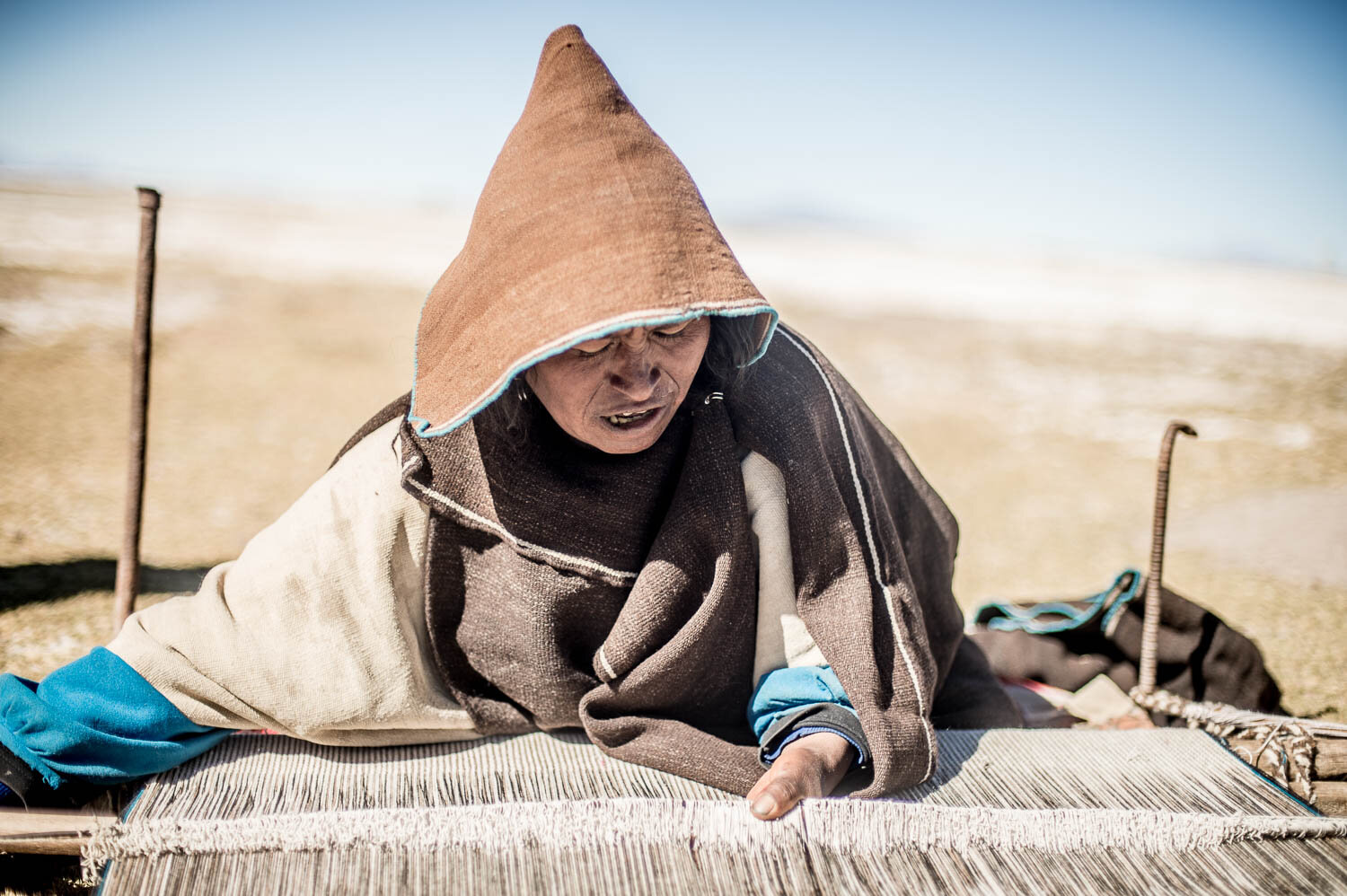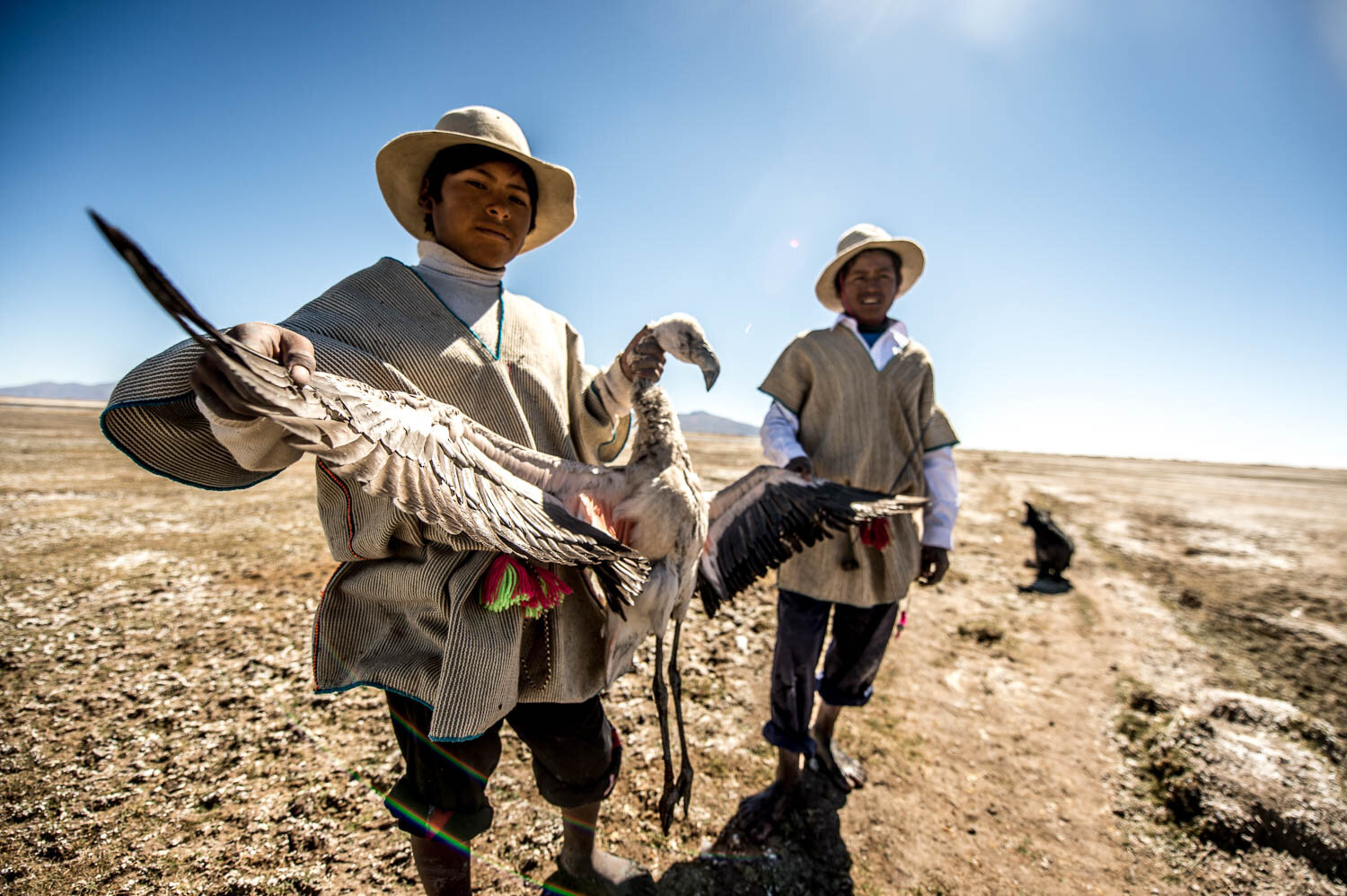
BOLIVIA’S CHIPAYA AND THE ALTIPLANO
The Chipaya are the living relic of an ancient past – the only remnant of the Tiwanaku civilization, which predates the Inca by 2,500 years.
Jose Luis Mamani Chino waits, motionless. The young Chipaya boy is pressed against the earth, one arm extended, his llama-wool poncho blending with the salt rich soil. A flock of flamingos flap lazily across the sky and he leaps to his feet, whipping a length of lead-weighted nylon called a sconi round his head three times before letting it go. One of the birds falters in its flight and plummets to the ground in a chaos of pink feathers.
As the 10 year old trots off to fetch his prey, I’m trying to square the whole spectacle with…well anything familiar. One tends to associate flamingos with the tropics. But we’re on a wind-whipped plateau high in the Bolivian Andes, snow-capped volcanoes breaking the horizon. And a little boy has just killed one of these iconic birds at 60 metres with a piece of string, some volcanic rock and a couple of lead balls. Presumably to eat it.
The Chipaya are the living relic of an ancient past. Anthropologists believe the tiny indigenous group to be the only remnant of the Tiwanaku civilization, which predates the Inca by 2,500 years. Their language and customs haven’t changed for millennia and they are cut off both geographically and culturally from the Quechua and Aymara ethnic groups that dominate the Altiplano, the world’s second highest plateau after Tibet.
The Chipaya seldom get visitors. They live in and around the small town of Santa Ana de Chipaya, on the starkly beautiful pampas that fringe the Coipasa salt desert, a smaller version of the Salar de Uyuni. The town itself is non-descript – adobe houses with corrugated iron roofs, a church, a cemetery. But most still live out on the plain, building circular homes of mud and thatch near the Lauca River, which swells and recedes with the passing seasons. It provides enough fresh water – just – to grow quinoa and tend llamas and sheep.
We leave Jose Luis to the hunt and meet his father Eloi Mamani Alabi, a 37-year old father of three, who welcomes us outside his conical home. He’s wearing the distinctive felt hat, white shirt and llama wool poncho by which Chipaya males are recognised. His wife’s poncho is darker and hooded. She sits at a loom, deftly manipulating the thick threads using a stick and a shell – Chipaya textiles are highly prized, fetching hundreds of dollars in the capital and can take weeks to complete. Their two sons Samuel and Jose Luis appear and their daughter Veronica peeps out shyly from the doorway.
Whether Jose Luis and his brother will still be here a decade from now is uncertain. “A lot of the young people are leaving this place,” Eloi tells us. “There is not enough land, not enough grazing for the sheep you need to raise a family.” The biggest problem according to Eloi is that the Lauca is drying up. “The river is the only reason we can live here,” he tells me. “If there is no more water, we must leave.” Many Chipaya cross the border to work in Chilean mines, or move to Bolivian cities like Oruro in search of work. But according to Eloi, they still feel like outsiders. “Our neighbours don’t want us – we are equal human beings, but they don’t recognize us.”
When I ask Eloi where the Chipaya came from, he says, “We have always been here. Before the chullpas we were here.” Chullpas are funerary towers that can be found scattered throughout the Peruvian and Bolivian Andes. Many still contain human remains, ancestors of the present day Aymara.
Anthropologists believe the Chipaya are direct descendants of the Uru ethnic group, which populated the Altiplano thousands of years before the Aymara came here. Like all indigenous Andean peoples, their religion is a syncretism of Christianity and animistic belief. They revere Pachamama, the ancient earth mother, an autochthonous deity whose presence is so ubiquitous in the Andes that when the Spanish sought to replace her with the Virgin Mary, Pachamama simply absorbed her identity.
After Jose Luis has killed another flamingo with the same relaxed assurance as the first, he sits plucking the birds’ feathers with his father. Veronica winds thread around a spindle, while their mother prepares a fire of dry tola brush inside one of the houses. As the afternoon passes, I am flooded with the sense of an ancient past, a way of living that endured on this unforgiving plateau for millennia. The feeling of suspended time soon passes though. Driving back through town, I spot some Chipaya boys who’ve climbed on top of a wall. I realize they are trying to get a mobile-phone signal.
Words by Johnny Langeneheim















